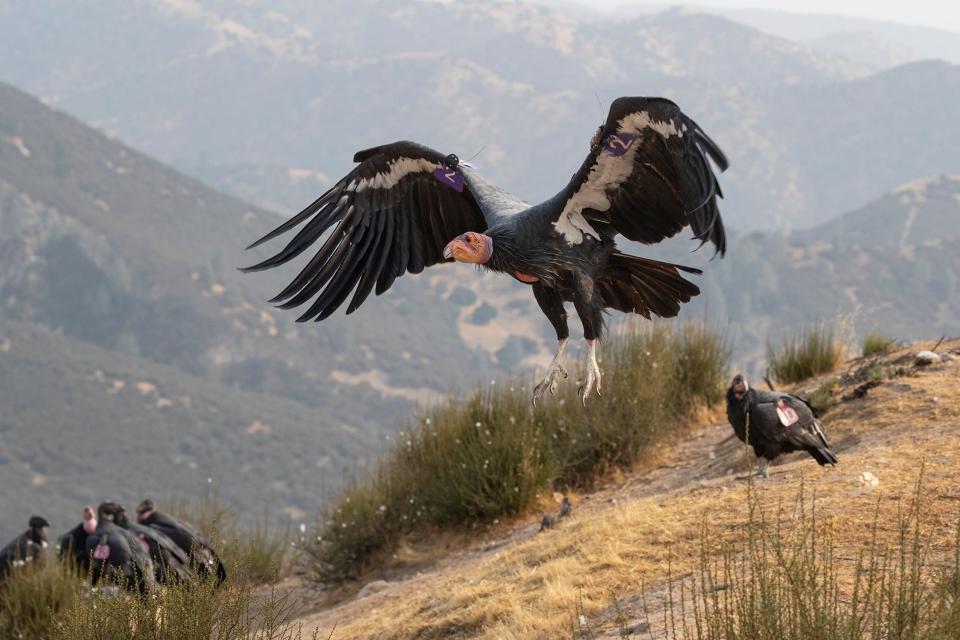California Condor chick survives after dramatic rescue effort
The egg laid by one of the endangered California Condors killed this spring by an outbreak of avian flu hatched a healthy female chick after an emergency effort to save it.
A team with the Peregrine Fund, one of a number of nonprofit partner groups that work to monitor and maintain condor populations in the wild, recovered the egg from a cliffside nest near the Utah-Arizona border on April 17, according to the group.
The egg was kept warm with heaters and towels as it was flown to an incubator run by Liberty Wildlife in Phoenix, where it hatched on May 9. The chick tested negative for Highly Pathogenic Avian Influenza (HPAI), the virus that is presumed to have killed its mother and dozens of other condors over the past year.
The chick was taken from there to a captive breeding facility in Boise, Idaho, where it was placed with a set of condor foster parents and was reportedly doing well.

"She's eating well from her foster parents and acting like a normal condor," Leah Esquivel, the propagation manager for the Peregrine Fund, said in an email.
The single chick carried special meaning for the teams who work with condors, having survived against the odds at a time when condor populations have been at risk because of the devastating outbreak of HPAI earlier this year.
At least 21 birds have died this spring in the Arizona-Utah flock of birds that is famous for nesting in and around the region's unique red-rock mesas and places like Zion National Park and the Vermillion Cliffs National Monument. The losses, which include at least eight breeding pairs, could set conservation efforts back decades, according to officials with the U.S. Fish and Wildlife Service.
More populations, more protection
Agencies have worked for decades to help the species recover. The largest flying land bird in North America, the condor was nearly killed off in the 20th century due to lead poisoning, hunting, habitat destruction and other human causes. After the 1920s, they had disappeared from around the Grand Canyon.
A reintroduction program first hatched in 1996 with the release of six birds into the wild near Zion National Park in Utah and Vermillion Cliffs in Arizona has seen slow but steady progress over the last 20 years, with the population growing to more than 115 birds as recently as last fall, according to a report from the Southwest Condor Working Group, a collaborative group trying to establish a healthy population in the area.
Between the Southwest working group and others being held in captivity or participating in similar programs in California and Baja, Mexico, there were more than 500 living condors, a significant improvement but a number still low enough that this year's flu deaths have been a major shock.
Observers with The Peregrine Fund first saw a sick condor in northern Arizona on March 9, the wildlife service said. The condor was found dead under her nest 11 days later, and testing confirmed she was positive for the highly contagious flu. More deaths quickly followed.
The 21 recent deaths are four times the number of deaths counted in the region all of last year.
Still, some condors do appear to be recovering. Eight sick condors were captured in Arizona and brought to a facility for treatment. Of those, four died and four others are still receiving care and showing signs of improvement, wildlife officials said.
Virus can be fatal

The highly contagious avian flu, H5N1, has affected more than 58 million birds in domestic poultry populations and wild flocks across the U.S. and continues to spread, federal officials report.
The Centers for Disease Control and Prevention says bird flu primarily strikes animals, but it has been detected in at least four human cases in the United States. An 11-year-old girl died of the flu in Cambodia in late February.
Since January 2022, 11 cases of H5N1 have been reported in people. The first 10 were exposed to poultry. Investigation into how the 11th person, a patient in Chile, was infected is ongoing, the Centers for Disease Control and Prevention said on March 30.
Symptoms include eye redness, flulike upper respiratory symptoms that range from mild to severe, fever and body aches.
More condor facts
The Peregrine Fund shares the following facts about condors:
They're one of the largest birds in North America, measuring 9.5 feet from wing tip to wing tip.
They're one of the longest-living raptors and may live to be 50 years old or more
Unlike some other birds, there's no difference in physical appearance between male and female condors.
Their wing tips point up when they fly, helping to reduce drag and soar for long periods of time.
They sleep or roost in tall trees or cliff crevasses
Like some other large birds, they poop on their legs when they get hot to stay cool as it evaporates
Lead poisoning is responsible for 49.8% of the 253 condor deaths where a cause could be determined since 1992.
Contributing: USA TODAY.
This article originally appeared on St. George Spectrum & Daily News: California Condor chick rescued after mother killed by avian flu

